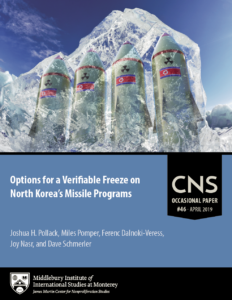April 30, 2019
Joshua H. Pollack, Miles Pomper, Ferenc Dalnoki-Veress, Joy Nasr, Dave Schmerler
Recent developments in US-North Korean diplomacy underscore the difficulty of achieving far-reaching disarmament objectives at a stroke. A verifiable freeze—a reversible halt to certain activities that the concerned parties are able to confirm—can serve as an initial step that promotes trust and creates space for patient, in-depth negotiations, while also providing concrete security benefits.
The freeze approach has been applied during the current round of diplomacy. Around the end of 2017, North Korea informally adopted a freeze on missile flight tests, and in April 2018, it declared a “suspension” of nuclear tests and long-range missile flight tests. After the June 2018 Singapore Summit, it also dismantled some missile- and space-related structures at one facility, notably including a large vertical test stand used for developing powerful liquid-propellant engines. North Korea has recently reversed this last step.
Returning to the idea of a freeze may provide a path around the present impasse in talks. To promote trust and create space for further negotiations, North Korea and its negotiating partners could exchange one or more packages of verifiable, reversible concessions, in addition to the steps already taken along these lines. A verifiable freeze should not only improve the atmosphere for negotiations, it can also provide tangible security benefits to the concerned parties.
This CNS occasional paper identifies and evaluates options for freezing the testing, production, and deployment of North Korean missiles, among other potential steps. These options might be pursued singly, in combination, or sequentially. The paper identifies some of the precedents for these activities and describes both the verification requirements and the security benefits associated with each option.
While it describes these trade-offs, the paper does not offer any single, specific recommendation. Policy makers must supply crucial value judgments, and any freeze agreement must be negotiated, including measures to be extended to the North Koreans. These matters are beyond the scope of the present analysis, but a better understanding of the options for a verifiable freeze of North Korea’s missile programs, it is hoped, can provide some of the “raw material” for creative policy making.

